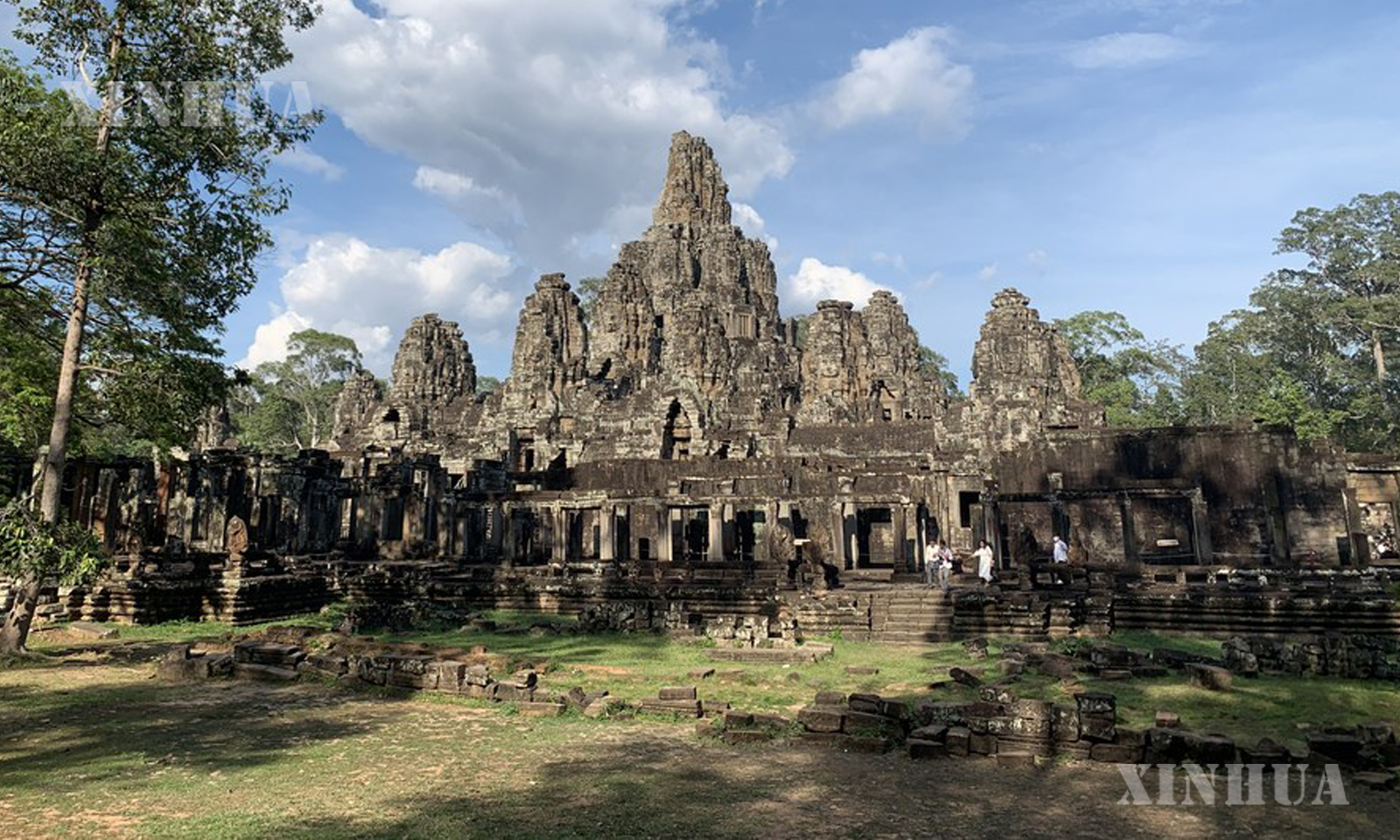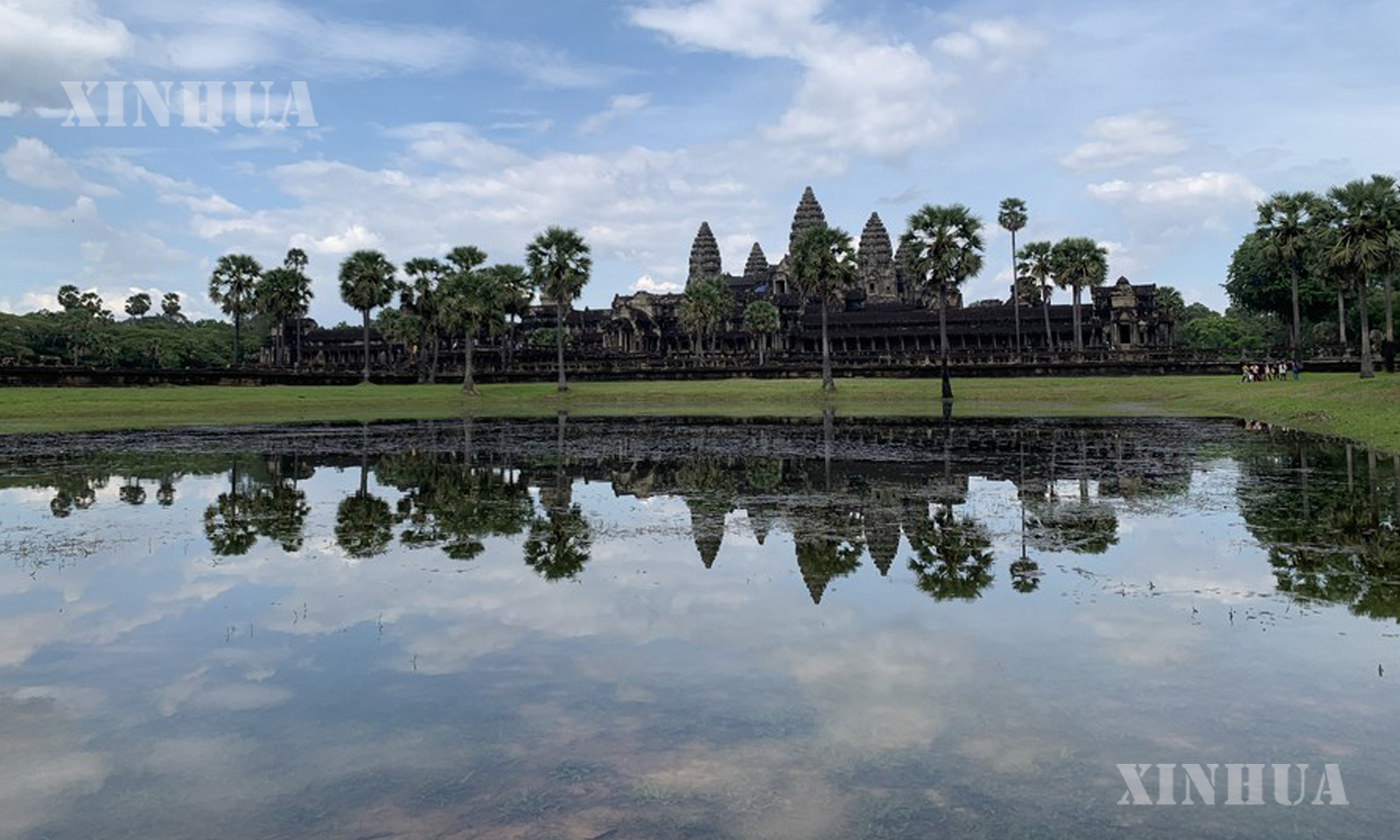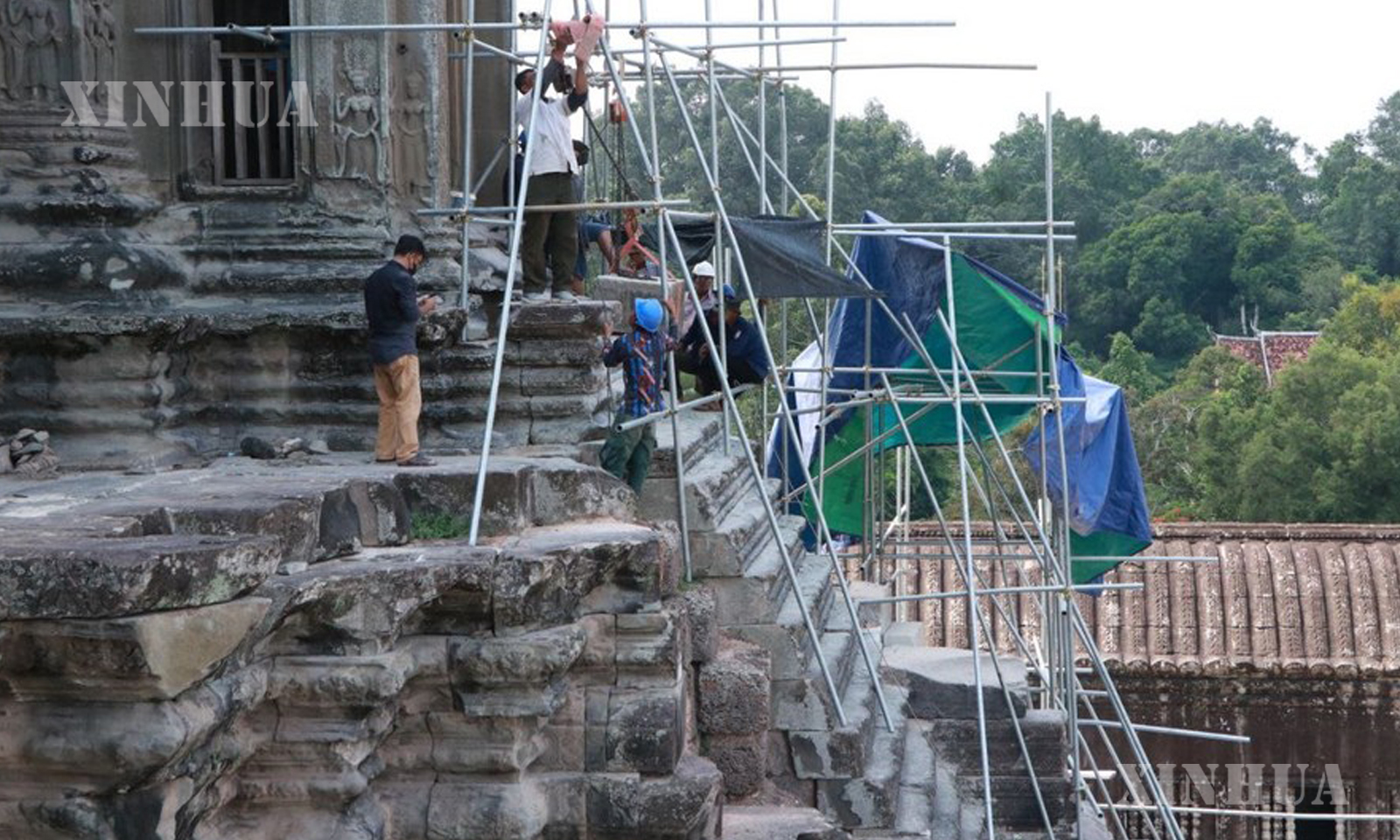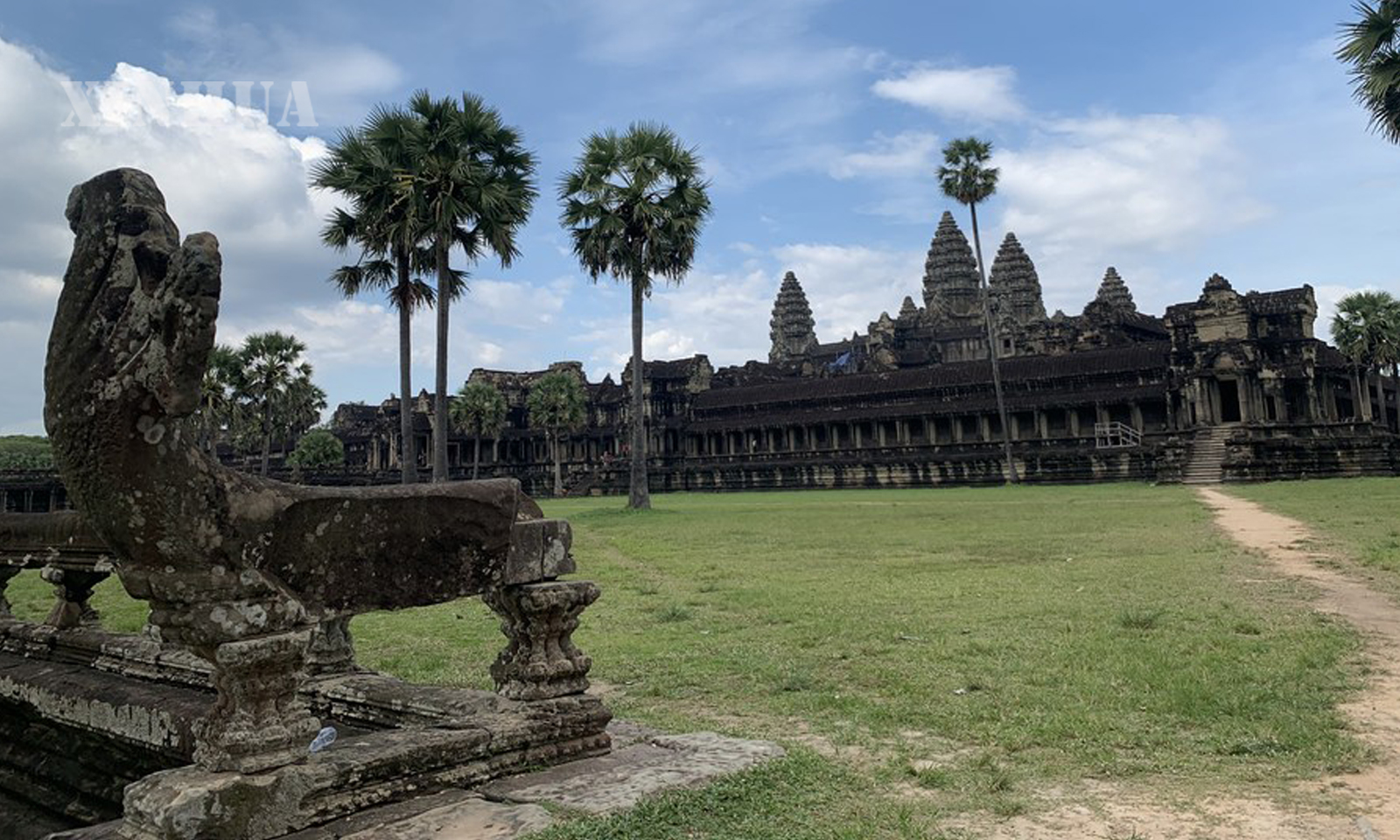Asia
ကမ္ဘောဒီးယားနိုင်ငံ၏ နာမည်ကျော် အန်ကော ရှေးဟောင်းသုတေသနဥယျာဉ် ထိန်းသိမ်းစောင့်ရှောက်ရန် တရုတ်နိုင်ငံက အဓိကကူညီပံ့ပိုးပေး

ဖနွမ်းပင်၊ ဧပြီ ၂၈ ရက် (ဆင်ဟွာ)
တရုတ်နိုင်ငံသည် ကမ္ဘောဒီးယားနိုင်ငံ အနောက်မြောက် ပိုင်းSiem Reap ပြည်နယ်ရှိ နာမည်ကျော် အန်ကော ရှေးဟောင်းသုတေသနဉယျာဉ် ထိန်းသိမ်းစောင့်ရှောက်ခြင်း၊ မူလအခြေအနေအတိုင်း ထိန်းသိမ်းခြင်းနှင့် ဖွံ့ဖြိုးတိုးတက်အောင်ဖော်ဆောင်ခြင်းအတွက် အဓိက ကူညီပံ့ပိုးပေးသူများအနက် တစ်ဦးဖြစ်ကြောင်း တာဝန်ရှိသူများက ဧပြီ ၂၇ ရက်က ပြောကြားခဲ့သည်။

ကမ္ဘောဒီးယားနိုင်ငံ Siem Reap ပြည်နယ် အန်ကော ရှေးဟောင်း သုတေသနဥယျာဉ်ရှိ အန်ကောဝပ် ဘုရားကျောင်းအား ဧပြီ ၅ ရက်က တွေ့ရစဉ် (ဆင်ဟွာ)

ကမ္ဘောဒီးယားနိုင်ငံ Siem Reap ပြည်နယ် ရှိAngkor Wat’s Bakan အား တွေ့ရစဉ် (ဓာတ်ပုံ – ANA/Handout via Xinhua)

ကမ္ဘောဒီးယားနိုင်ငံ Siem Reap ပြည်နယ် အန်ကော ရှေးဟောင်း သုတေသနဥယျာဉ်ရှိ အန်ကောဝပ် ဘုရားကျောင်းအား ဧပြီ ၅ ရက်က တွေ့ရစဉ် (ဆင်ဟွာ)
၁၉၉၂ ခုနှစ်တွင် ကုလသမဂ္ဂ ပညာရေး၊ သိပ္ပံနှင့် ယဉ်ကျေးမှုအဖွဲ့ (ယူနက်စကို) ၏ ကမ္ဘာ့အမွေအနှစ်စာရင်းတွင် စာရင်းဝင်ထားသော Angkor ရှေးဟောင်းသုတေသနဥယျာဉ်သည် ကမ္ဘောဒီးယားနိုင်ငံ၌ အကျော်ကြားဆုံး ခရီးသွားဧည့်သည်များ လာရောက်လည်ပတ်သောနေရာဖြစ်သည်။
ဧရိယာ ၄၀၁ စတုရန်းကီလိုမီတာ ကျယ်ဝန်းပြီး အန်ကောရှေးဟောင်းသုတေသနဉယျာဉ်သည် ကိုးရာစုမှ ၁၅ ရာစုအထိ ခမာအင်ပါယာ၏ အမျိုးမျိုးသော မြို့တော်များ၏ ကြီးကျယ်ခမ်းနားမှုအဖြစ် ကျန်ရှိနေဆဲဖြစ်ကာ ယင်းဥယျာဉ်ရှိ အခြားနေရာများအနက် အန်ကောဝပ်၊ Angkor Thom ၊ Bayon ၊ Chau Say Tevoda နှင့် Ta Keo စသဖြင့် အဓိက ဘုရားကျောင်းများစွာ ပါဝင်သည်။
အဆိုပါ ဉယျာဉ်အား စီမံခန့်ခွဲခြင်း၊ ထိန်းသိမ်းစောင့်ရှောက်ခြင်းနှင့် မူလအခြေအနေအတိုင်း ထိန်းသိမ်းခြင်းဆိုင်ရာ တာဝန်ယူထားသော အစိုးရအေဂျင်စီဖြစ်သည့် Apsara National Authority ၏ ပြောရေးဆိုခွင့်ရှိသူနှင့် လက်ထောက်ညွှန်ကြားရေးမှူးချုပ် Long Kosal က တရုတ်နိုင်ငံသည် ၁၉၉၇ ခုနှစ်မှ စတင်၍ ယင်းဉယျာဉ်ရှိ ပျက်စီးနေသော ဘုရားကျောင်းများကို ပြန်လည်ထိန်းသိမ်းခဲ့ပြီး Chau Say Tevoda ဘုရားကျောင်းနှင့် Ta Keo တို့ကိုလည်း အောင်မြင်စွာ ပြန်လည်တည်ဆောက်လျက်ရှိကြောင်း ပြောကြားခဲ့သည်။
Chau Say Tevoda ဘုရားကျောင်း ပြန်လည်ထိန်းသိမ်းရေးလုပ်ငန်းကို ၂၀၀၈ ခုနှစ်တွင် ပြီးစီးခဲ့ပြီး Ta Keo ဘုရားကျောင်း ပြုပြင်ထိန်းသိမ်းရေးကိုမူ ၂၀၁၀ ခုနှစ်နှောင်းပိုင်းတွင် စတင်ခဲ့ကာ၂၀၁၈ ခုနှစ်၌ ပြီးစီးခဲ့ကြောင်း ၎င်းက ဆိုသည်။
“၂၀၁၉ ခုနှစ်ကတည်းက တရုတ် ကျွမ်းကျင်ပညာရှင်တွေဟာ Angkor Thom တော်ဝင်နန်းတော်ရဲ့ တံတိုင်းအတွင်းရှိ Phimeanakas ဘုရားကျောင်းရဲ့ ၁၁ နှစ်ကြာ ပြန်လည်ပြုပြင်ထိန်းသိမ်းရေးစီမံကိန်းကို စတင်လုပ်ဆောင်လျက်ရှိပါတယ်” ဟု ၎င်းက ဆင်ဟွာသို့ ပြောကြားခဲ့သည်။
၁၀ ရာစုအလယ်ပိုင်းက တည်ဆောက်ခဲ့ပြီး အရှည် ၅၈၁ မီတာနှင့် အကျယ်အဝန်း ၂၄၂ မီတာရှိသော Phimeanakas ဘုရားကျောင်းအား တော်ဝင်နန်းတော်တွင် ဝတ်ပြုနေရာနေရာအဖြစ် ထည့်သွင်းစဉ်းစားထားကြောင်း သိရသည်။
COVID-19 ကပ်ရောဂါ ဖြစ်ပွားနေသော်လည်း ပြုပြင်မွမ်းမံရေးလုပ်ငန်းများကို အဆင်ပြေချောမွေ့စွာ ဆက်လက်ဆောင်ရွက်ဆဲဖြစ်ကြောင်း Kosal က ပြောခဲ့သည်။
“အန်ကောဥယျာဉ်ကို ကာကွယ်စောင့်ရှောက်ရေး၊ မူလအခြေအနေအတိုင်း ပြုပြင်မွမ်းမံခြင်းနဲ့ ဖွံ့ဖြိုးတိုးတက်အောင်ဖော်ဆောင်ရေးတွေမှာ တရုတ်နိုင်ငံရဲ့ တက်တက်ကြွကြွ ပါဝင်ကူညီမှုကို ကျွန်တော်တို့ အလွန်တန်ဖိုးထားပါတယ်” ဟု ၎င်းက ပြောကြားခဲ့သည်။ “တရုတ်ရဲ့အကူအညီက ကျွန်တော်တို့ရဲ့ ယဉ်ကျေးမှုအမွေအနှစ်တွေ စဉ်ဆက်မပြတ် ဖွံ့ဖြိုးတိုးတက်လာစေဖို့ အထောက်အကူဖြစ်စေရုံသာမကဘဲ ပြန်လည်ပြုပြင်မွမ်းမံရေး၊ မူလအခြေအနေအတိုင်း ထိန်းသိမ်းခြင်းဆိုင်ရာ ကမ္ဘောဒီးယား ကျွမ်းကျင်ပညာရှင်တွေကိုလည်း အကူအညီပေးခဲ့တယ်” ဟုဆိုသည်။
တစ်ချိန်တည်းမှာပင် ကပ်ရောဂါကာလအတွင်း ယင်းဥယျာဉ်နေရာသို့ ကမ္ဘာလှည့်ခရီးသွားဧည့်သည်များ လာရောက်လည်ပတ်မှု နည်းပါးချိန်တွင် Apsara National Authority က ပြုပြင်မွမ်းမံခြင်း၊ ပြုပြင်ထိန်းသိမ်းခြင်းနှင့် ဥယျာဉ်အတွင်း သာယာလှပရေးအတွက် ဥယျာဉ်စိုက်ပျိုးရေးဆိုင်ရာ လုပ်ငန်းတွေဆောင်ရွက်ရန် အခွင့်အရေးရရှိခဲ့ကြောင်း သိရသည်။
“အခုဆိုရင် အန်ကော ရှေးဟောင်းသုတေသနဥယျာဉ်ဟာ ကမ္ဘာတစ်ဝန်းက ခရီးသွားအားလုံးကို ကြိုဆိုဖို့ အဆင်သင့်ဖြစ်နေပါပြီ” ဟု ၎င်းက ဆိုသည်။ “ကျွန်တော်တို့နိုင်ငံဟာ ကာကွယ်ဆေးအပြည့်ထိုးထားတဲ့ ခရီးသွားဧည့်သည်တွေအတွက် ကွာရန်တင်း (Quarantine) မလိုဘဲ နယ်စပ်တွေကို ပြန်လည်ဖွင့်လှစ်လိုက်တာကြောင့် မကြာမီကာလအတွင်းမှာ နိုင်ငံတကာခရီးသွားတွေအနေနဲ့ သူတို့ရဲ့ အားလပ်ရက်တွေကို အန်ကောဥယျာဉ်ထံ လာရောက်လည်ပတ်ကြမယ်လို့ ယုံကြည်ပါတယ်”
ကပ်ရောဂါမဖြစ်ပွားမီ အန်ကောဥယျာဉ်သည် ၂၀၁၉ ခုနှစ်တွင် နိုင်ငံတကာဧည့်သည် ၂.၂ သန်းအထိ ဆွဲဆောင်နိုင်ခဲ့ပြီး လက်မှတ်ရောင်းချမှုမှ ဝင်ငွေ အမေရိကန်ဒေါ်လာ ၉၉ သန်း ရရှိခဲ့ကြောင်း သိရသည်။
အန်ကောဥယျာဉ်သို့ ယခုနှစ် ဇန်နဝါရီ-မတ် ကာလအတွင်း နိုင်ငံခြားခရီးသွား ၁၉,၈၄၀ ဦး ဝင်ရောက်ခဲ့ပြီး ယမန်နှစ် အလားတူကာလအတွင်း ဝင်ရောက်ခဲ့သော ခရီးသွားဧည့်သည် ၄,၄၈၂ ဦးမှ ၃၄၂ ရာခိုင်နှုန်းကျော် မြင့်တက်လာခဲ့ကြောင်း၊ ၂၀၂၂ ခုနှစ် ပထမသုံးလပတ်အတွင်း ဖြည်းဖြည်းချင်း ပြန်လည်နာလန်ထူလာခဲ့ကြောင်း ခရီးသွားလုပ်ငန်း ဝန်ကြီးဌာန၏ အတွင်းဝန်နှင့် ပြောရေးဆိုခွင့်ရှိသူ Top Sopheak က ပြောကြားခဲ့သည်။
“အခုတော့ အန်ကောဥယျာဉ်ဟာ တစ်ရက်လျှင် နိုင်ငံခြားခရီးသွားဧည့်သည် ၄၀၀ ခန့်ကို ဆွဲဆောင်ခဲ့ပြီး လွန်ခဲ့သော ၂ နှစ် ကပ်ရောဂါကာလအတွင်းက တစ်ရက်လျှင် ၇၀ ဦးသာရှိရာမှ ဖြည်းဖြည်းချင်း တိုးလာတာဖြစ်ပါတယ်” ဟု ၎င်းက ဆင်ဟွာသို့ ပြောကြားခဲ့သည်။
ကပ်ရောဂါမဖြစ်ပွားမီက အဆိုပါနေရာသို့ တစ်ရက်လျှင် နိုင်ငံတကာခရီးသွားဧည့်သည် ၉,၀၀၀ အထိ လက်ခံရရှိခဲ့ သိရသည်။
ကမ္ဘောဒီးယားနိုင်ငံအတွင်း လူမှုစီးပွားလုပ်ငန်းများ အပြည့်အဝ ပြန်လည်ဆောင်ရွက်ပြီး ကာကွယ်ဆေးထိုးနှုန်း မြင့်မားမှုကြောင့် ကွာရန်တင်း ကန့်သတ်ထားခြင်းမရှိဘဲ ကာကွယ်ဆေး အပြည့်အဝထိုးနှံထားသော ခရီးသွားဧည့်သည်များအတွက် နယ်စပ်များကို ပြန်လည်ဖွင့်လှစ်ပြီးနောက် ခရီးသွားနှင့် ခရီးသွားလုပ်ငန်းရှင်များက ၎င်းတို့၏ စီးပွားရေးလုပ်ငန်းများကို ပြန်လည်စတင်ခဲ့ကြောင်း ခရီးသွားလုပ်ငန်းဝန်ဆောင်မှုများအသင်း ဥက္ကဋ္ဌ Chhay Sivlin က ပြောကြားခဲ့သည်။
“နိုင်ငံတကာ ခရီးသွားဧည့်သည်တွေအနေနဲ့ ကမ္ဘောဒီးယားနိုင်ငံကို ဖြည်းဖြည်းချင်း ပြန်လည်ဝင်ရောက်လာဖို့ မျှော်လင့်ပါတယ်။ အထူးသဖြင့် အန်ကောဆီကိုပေါ့။ ဘာဖြစ်လို့လဲဆိုတော့ ကမ္ဘောဒီးယားနဲ့ အခြားနိုင်ငံတွေကြား လေကြောင်းခရီးစဉ် အမြောက်အများလည်း ပြန်လည်ပြေးဆွဲနေပြီလေ” ဟု ၎င်းက ပြောခဲ့သည်။ (Xinhua)
…………………………………..
(English Version)
China key contributor to safeguarding Cambodia’s famed Angkor Archaeological Park
Source: Xinhua
Editor: huaxia
2022-04-28 09:18:14
Cambodian officials said China had helped restore ruined temples in Angkor Archaeological Park since 1997 by successfully restoring the Chau Say Tevoda temple and the Ta Keo temple.
PHNOM PENH, April 28 (Xinhua) — China has been one of the key contributors to safeguarding, preserving and developing the famed Angkor Archaeological Park in northwest Cambodia’s Siem Reap province, officials said on Wednesday.
The Angkor Archaeological Park, inscribed on the World Heritage List of the United Nations Educational, Scientific and Cultural Organization (UNESCO) in 1992, is the most popular tourist destination in the Southeast Asian nation.
Covering an area of 401-square kilometers, the Angkor site contains the magnificent remains of the different capitals of the Khmer Empire from the ninth to the 15th century, and it consists of scores of key temples such as the Angkor Wat, Angkor Thom, Bayon, Chau Say Tevoda and Ta Keo, among others.
Long Kosal, deputy director-general and spokesman for the Apsara National Authority, which is the government agency responsible for managing, safeguarding and preserving the site, said China has helped restore ruined temples there since 1997, restoring the Chau Say Tevoda temple and the Ta Keo temple successfully.
He said the restoration work on the Chau Say Tevoda was completed in 2008 and on the Ta Keo, which started in late 2010, was concluded in 2018.
“And since 2019, the Chinese experts have begun working on the 11-year restoration project of the Phimeanakas temple located inside the walled enclosure of the Royal Palace of the Angkor Thom,” he told Xinhua.
Built in the middle of the 10th century, the Phimeanakas temple was considered a place of worship in the Royal Palace, which covered an area of 581 meters long and 242 meters wide.
Kosal said that despite the COVID-19 pandemic, the restoration work is still going on smoothly.
“We highly value China’s active contribution to the protection, preservation and development of the Angkor,” he said. “China’s assistance has not only contributed to ensuring the sustainable development of our cultural heritage, but also helped train Cambodian experts on restoration and preservation work.”
Meanwhile, Kosal said that during the pandemic when few tourists visited the site, the Apsara National Authority had taken the opportunity to do renovation work, maintenance and gardening at the site in order to improve its beauty.
“Now, the Angkor Archaeological Park is ready to welcome all tourists from around the world,” he said. “As our country has reopened its borders to fully vaccinated travelers without quarantine, I believe that more international tourists will spend their holidays visiting the Angkor in the near future.”
Prior to the pandemic, the Angkor attracted up to 2.2 million international visitors in 2019, earning 99 million U.S. dollars in revenue from ticket sales.
Tourism ministry’s secretary of state and spokesman Top Sopheak said the number of foreign tourists to the Angkor has gradually recovered in the first quarter of 2022, adding that it received 19,840 foreign tourists during the January-March period this year, up 342 percent from 4,482 over the same period last year.
“Now, the Angkor attracts about 400 foreign tourists a day, a gradual increase from only 70 per day during the pandemic in the past two years,” he told Xinhua.
Sopheak recalled that prior to the pandemic, the site received up to 9,000 international visitors a day.
Chhay Sivlin, president of the Cambodia Association of Travel Agents, said some tour and travel operators have restarted their businesses after the country has fully resumed its socioeconomic activities and reopened its borders to vaccinated travelers without quarantine, buoyed by high vaccination rates.
“We hope that international visitors will gradually return to Cambodia, especially to the Angkor, because several flights between Cambodia and other countries have been resumed,” she said. ■
Photo 1 : Photo taken on April 5, 2022 shows the Bayon Temple in the Angkor Archeological Park in Siem Reap province, Cambodia. (Photo by Van Pov/Xinhua)
Photo 2 : Photo taken on April 5, 2022 shows the Angkor Wat Temple in the Angkor Archeological Park in Siem Reap province, Cambodia. (Photo by Van Pov/Xinhua)
Photo 3 : Undated photo shows the restoration site of Angkor Wat’s Bakan tower in Siem Reap, Cambodia. (ANA/Handout via Xinhua)
Photo 4 : Photo taken on April 5, 2022 shows the Angkor Wat Temple in the Angkor Archeological Park in Siem Reap province, Cambodia. (Photo by Van Pov/Xinhua)






